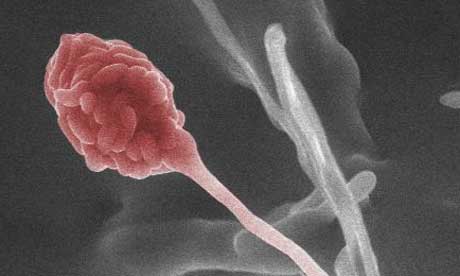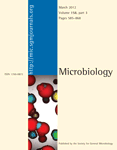导读:Strobel在巴塔哥尼亚北部发现了一种树木,在常态下,它们身上的微生真菌会释放出气体。在缺氧情况下,就逸出一系列易挥发的碳水分子,这些碳水分子通常只会在石油里发现。这些微生物以纤维素为食。那些苦苦寻找生产农业碳氢燃料又不想占用粮食作物的企业,将会对这项发现感兴趣。

Gliocladium roseum
我们总是需要比自己小的人。美国Montana大学的Gary Strobel的发现再次证明了这点。这个科学家发现,粘帚粉红聚端孢(Gliocladium roseum)在缺氧的情况下可以产生碳氢化合物。这些混合物质让人不禁想起汽油。
Strobel绝非无名小卒。他访遍整个世界为了找到植物身上有用的微生物。他的一项著名发现,是在1993年时发现一种真菌能帮助形成泰克索(一种抗癌物质)。他还发现一种可以从中提取50多个分子的细菌。但是1987年,为了试图治愈患有荷兰榆树病的树木,他在Montana森林里进行了一项非法的生物实验,差一点毁了他的事业。尽管受到非议,他从没停止过寻找微生物。
这个月,Microbiology杂志发表了他的粘帚粉红聚端孢(Gliocladium roseum)具有能源功效的发现。这种真菌已经用于对抗草莓灰色腐烂。Strobel在巴塔哥尼亚北部发现了一种树木,在常态下,它们身上的微生真菌会释放出气体。在缺氧情况下,就逸出一系列易挥发的碳水分子,这些碳水分子通常只会在石油里发现。这些微生物以纤维素为食。那些苦苦寻找生产农业碳氢燃料又不想占用粮食作物的企业,将会对这项发现感兴趣。
很明显,Strobel很知道排除后顾之忧。他以为“微生-石油”申请了专利,开始解密寄生虫的基因组,以便发现是哪种基因会产生该碳氢物质。但是可能得需要几年时间来确认是否解决汽车用油难问题的福星存在于微生真菌里。

Modulation of volatile organic compound formation in the Mycodiesel-producing endophyte Hypoxylon sp. CI-4
Syed Riyaz Ul-Hassan, Gary A. Strobel, Eric Booth, Berk Knighton, Cody Floerchinger and Joe Sears
An endophytic Hypoxylon sp. (strain CI-4) producing a wide spectrum of volatile organic compounds (VOCs), including 1,8-cineole, 1-methyl-1,4-cyclohexadiene and cyclohexane, 1,2,4-tris(methylene), was selected as a candidate for the modulation of VOC production. This was done in order to learn if the production of these and other VOCs can be affected by using agents that may modulate the epigenetics of the fungus. Many of the VOCs made by this organism are of interest because of their high energy densities and thus the potential they might have as Mycodiesel fuels. Strain CI-4 was exposed to the epigenetic modulators suberoylanilide hydroxamic acid (SAHA, a histone deacetylase) and 5-azacytidine (AZA, a DNA methyltransferase inhibitor). After these treatments the organism displayed striking cultural changes, including variations in pigmentation, growth rates and odour, in addition to significant differences in the bioactivities of the VOCs. The resulting variants were designated CI4-B, CI4-AZA and CI4-SAHA. GC/MS analyses of the VOCs produced by the variants showed considerable variation, with the emergence of several compounds not previously observed in the wild-type, particularly an array of tentatively identified terpenes such as α-thujene, sabinene, γ-terpinene, α-terpinolene and β-selinene, in addition to several primary and secondary alkanes, alkenes, organic acids and derivatives of benzene. Proton transfer reaction mass spectroscopic analyses showed a marked increase in the ratio of ethanol (mass 47) to the total mass of all other ionizable VOCs, from ~0.6 in the untreated strain CI-4 to ~0.8 in CI-4 grown in the presence of AZA. Strain CI4-B was created by exposure of the fungus to 100 µM SAHA; upon removal of the epigenetic modulator from the culture medium, it did not revert to the wild-type phenotype. Results of this study have implications for understanding why there may be a wide range of VOCs found in various isolates of this fungus in nature.
文献链接:
https://mic.sgmjournals.org/content/158/2/465.abstract?sid=269bcb16-eacc-49e7-bc69-5890e2d02507








